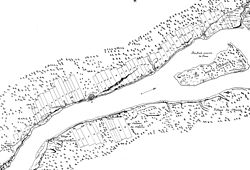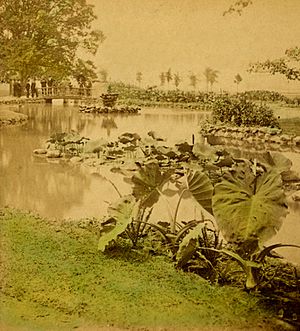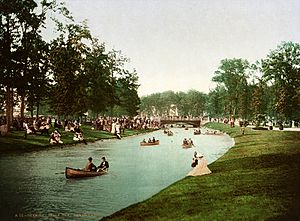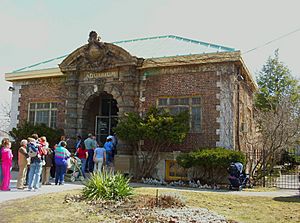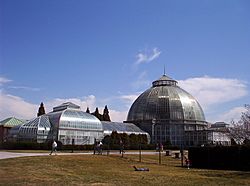Belle Isle Park (Michigan) facts for kids
Quick facts for kids Belle Isle Park |
|
|---|---|
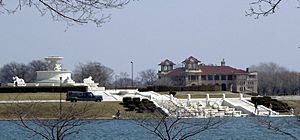
James Scott Memorial Fountain, with the Belle Isle Casino in the background
|
|
| Lua error in Module:Location_map at line 420: attempt to index field 'wikibase' (a nil value). | |
| Type | State park |
| Location | Detroit, Michigan, U.S. |
| Area | 982 acres (397 ha) |
| Created | 1845 (2014 as a state park) |
| Operated by | State of Michigan |
| Website | Official website: http://www.belleislepark.org/ |
|
Belle Isle
|
|
| Location | Detroit River |
| Architect | Frederick Law Olmsted |
| NRHP reference No. | 74000999 |
| Added to NRHP | February 25, 1974 |
Belle Isle Park, often called Belle Isle, is a large island park in Detroit, Michigan. It covers about 982 acres (almost 4 square kilometers). The park is on an island in the Detroit River, surrounded by smaller islands. The border between the U.S. and Canada runs south of Belle Isle, so the island is fully in the United States.
Belle Isle is owned by the city of Detroit. However, it is managed as a state park by the Michigan Department of Natural Resources. This arrangement started in 2013 with a 30-year agreement. Before that, it was a city park. Belle Isle Park is the biggest city-owned island park in the U.S. It is also the third largest island in the Detroit River. Only Grosse Ile and Fighting Island are bigger. A bridge called the MacArthur Bridge connects Belle Isle to mainland Detroit.
Belle Isle Park has many cool places to visit. These include the Belle Isle Aquarium, the Belle Isle Conservatory, and the Belle Isle Nature Center. You can also find the James Scott Memorial Fountain, the Dossin Great Lakes Museum, a golf course, and a swimming beach. A Coast Guard station is also on the island. The Detroit Yacht Club is on a nearby island, connected to Belle Isle by a bridge.
Contents
History of Belle Isle Park
French settlers first came to the island in the 1700s. They called it Île aux Cochons, which means "Hog Island." They let their farm animals roam freely there.
After the War of 1812, American General Alexander Macomb, Jr. owned the island. He later became the head of the U.S. Army.
On July 4, 1845, people had a big picnic on the island. They decided to change its name to "Belle Isle." This was to honor Miss Isabelle Cass, whose father was Governor Lewis Cass. The name Belle Isle means "beautiful island" in French.
The city wanted to turn the island into a park. They hired Frederick Law Olmsted in the 1880s to design it. Olmsted is famous for designing Central Park in New York City. However, only some of his plans for Belle Isle were built.
The Belle Isle Casino building, built in 1908, is not used for gambling. It is used for public events. Other important places on Belle Isle include a botanical garden and the Belle Isle Conservatory (1904). Both were designed by Detroit architect Albert Kahn. He also designed other famous buildings in Detroit.
In 1908, a car company owner named Byron Carter stopped to help a driver on Belle Isle. When he tried to start her car, it kicked back and broke his jaw. He later got sick and died. Because of this, Henry Leland, who started Cadillac Motors, wanted to make cars safer. He hired Charles Kettering to invent the electric self-starter. This invention soon became a standard feature on all cars.
Architect Cass Gilbert designed the James Scott Memorial Fountain on Belle Isle. It was finished in 1925. Gilbert also designed the United States Supreme Court Building in Washington, D.C. The William Livingstone Memorial Light is on the east end of the island. It is the only marble lighthouse in the United States. It was named after William Livingstone, who worked to make shipping safer on the Great Lakes.
During World War II, the U.S. military used the island for training. They even re-created a Pacific island invasion there. The island was temporarily called Bella Jima. Detroiters could see a pretend invasion without any real fighting. This event happened after the U.S. successfully invaded Iwo Jima.
The island once had a canoe rental place. People could rent canoes or store their own. Canoe riders often stopped at the Remick Band Shell. This band shell hosted concerts from 1950 to 1980. It was named after Jerome H. Remick, who owned a very large music publishing company.
The Detroit Boat Club used buildings on the island from 1902 to 1996. The marina and building are now closed. Only rowing activities still happen there. The Belle Isle Golf Course opened in 1922. The Detroit Yacht Club building, built in 1923, is still an active private club. It offers swimming and other activities. The Flynn Pavilion (1949) was designed by Eero Saarinen. It was used for ice skating rentals.
A ferry used to take people to the island from 1840 to 1957. A bridge to the island was finished in 1923. Horse riding stables were in an old market building. This building was moved to the island from Detroit in the 1890s. The park headquarters and police station are in houses from the 1860s.

From the 1890s, many European fallow deer lived on the island. But this group of deer got sick in the late 1900s. In 2004, the last 300 deer were moved to the Detroit Zoo and the nature center on Belle Isle. The children's zoo on the island and the aquarium closed because of money problems.
The Belle Isle Aquarium reopened on August 18, 2012. The Belle Isle Conservancy now runs it. It first opened on August 18, 1904. It was the oldest public aquarium in North America that was always open. It closed on April 3, 2005. The aquarium is open to the public for free on Saturdays and Sundays. The building is 10,000 square feet (930 square meters). It has a large room with a curved ceiling covered in green glass tiles. This makes it feel like you are underwater.
After years of financial problems, the city of Detroit faced difficulties in 2013. The state government decided to help manage the city's money. As part of this, the state suggested taking over Belle Isle and making it a state park. Michigan Governor Rick Snyder signed an agreement on October 1, 2013. The state would lease the park from the city for 30 years. Belle Isle officially became a state park on February 10, 2014.
People who drive or ride motorcycles into the state park need to pay a small fee. Or, they can have a Michigan Recreational Passport sticker on their license plate. There is no charge for people who walk, bike, or jog into the park.
Belle Isle was Michigan's most visited state park in 2016. More than 4 million people visited it. Since the state took over in 2014, it has spent $32 million to improve the park.
The park is also one end of the Iron Belle Trail. This trail has separate paths for hiking and biking across the state.
Fun Events at Belle Isle
Auto Racing
In 1992, a temporary race track was built on the island for CART races. The island hosted ten races from 1992 to 2001. Racing started again in 2007 with the IndyCar Series.
The race planned for 2009 was canceled. This was because of money problems affecting the Detroit area. But the race returned in 2012. It has been held every year since then. The race weekend includes IndyCar races and other sports car races.
Music Concerts
There are plans to bring back summer concert band performances at the Remick Band Shell. Different concert bands from the Detroit area plan to play on Sunday afternoons.
In 2013, the famous heavy metal band Metallica held their Orion Music + More Festival on Belle Isle. This brought in money for the park. However, the festival was later canceled for good because of financial issues.
Soccer Games
Belle Isle used to be home to the Detroit Futbol League. But now, games are played at the Fort Wayne grounds. This is because of the condition of the fields at Belle Isle.
Rent a Boat
You can rent canoes, paddleboats, and kayaks at the Flynn Pavilion. This is a great way to explore the island's waterways.
Amazing Attractions to See
James Scott Memorial Fountain
The James Scott Memorial Fountain is a large monument in Belle Isle Park. Architect Cass Gilbert and sculptor Herbert Adams designed it. The fountain was finished in 1925 and cost $500,000. The bottom part of the fountain is 510 feet (160 meters) wide. The water spray in the middle can go as high as 125 feet (38 meters). The fountain honors James Scott, who left money to the city of Detroit for a fountain in his memory.
Belle Isle Aquarium
The Belle Isle Aquarium is a public aquarium in Belle Isle Park. Architect Albert Kahn designed it. It first opened on August 18, 1904. It was the oldest public aquarium in North America that was always open. It closed on April 3, 2005. The aquarium reopened to the public on August 18, 2012. The Belle Isle Conservancy now runs it. The building is 10,000 square feet (930 square meters). It has one large room with a curved ceiling covered in green glass tiles. This makes it feel like you are underwater.
Belle Isle Conservatory
The Anna Scripps Whitcomb Conservatory, also known as the Belle Isle Conservatory, is a large greenhouse and botanical garden. It opened in 1904. It is about three miles (4.8 km) east of downtown Detroit. The conservatory covers 13 acres (about 5 hectares).
The Belle Isle Conservatory was built in 1904 and designed by Albert Kahn. It was rebuilt between 1952 and 1954. In 1953, it was named after Anna Scripps Whitcomb. She gave her collection of 600 orchid plants to the city. Thanks to her gift, the conservatory now has one of the biggest orchid collections owned by a city in the U.S. Some rare orchids were even saved from bombings during World War II and brought here.
The conservatory has beautiful gardens outside. These include formal perennial gardens, flower beds, a rose garden, and a lily pond. The conservatory building itself covers more than an acre. It has a tall central dome that is 85 feet (26 meters) high. Inside, you can find different plant areas. The south wing has tropical plants like bananas, oranges, coffee, and sugar cane. The north wing has many ferns, cacti, and succulent plants. The show house always has blooming plants on display. The conservatory is currently being fixed up and will reopen soon.
Belle Isle Nature Center
The Belle Isle Nature Center (BINC) is a special place that covers about 4 acres (1.6 hectares) of natural forest wetland on Belle Isle. The nature center offers learning, fun, and environmental programs all year round.
One popular feature is the Deer Encounter. Here, visitors can feed the fallow deer that used to live freely on the island. The BINC also has a renovated auditorium, an exhibit with native Michigan turtles, and an indoor beehive. You can watch bees all year long! There's also a spider exhibit and a Creation Station for kids' activities.
Dossin Great Lakes Museum
The Dossin Great Lakes Museum is a maritime museum. It is located on The Strand in Belle Isle Park. This museum focuses on Detroit's important role in the history of ships and boating on the Great Lakes. The museum is 16,000 square feet (about 1,486 square meters). It has one of the world's largest collections of model ships. It also has the front anchor from the famous ship, the SS Edmund Fitzgerald.
Park Size and Importance
Belle Isle Park is 982 acres (about 4 square kilometers). Before it became a state park, it was the largest city island park. It is even bigger than Central Park in New York City, which was also designed by Olmsted.
Detroit's River Rouge Park is even larger, at 1,172 acres (about 4.7 square kilometers). The Huron-Clinton Metroparks manage many other parks and beaches in the area. There are thousands of acres of parks in metropolitan Detroit.
Gallery
-
Friedrich Schiller, the German writer and philosopher, statue on Belle Isle
-
View of Downtown Detroit from Belle Isle
-
Nancy Brown Peace Carillon Clock on Belle Isle
-
Detroit Yacht Club in Belle Isle Park
-
SS Edmund Fitzgerald bow anchor
Images for kids


